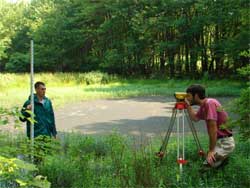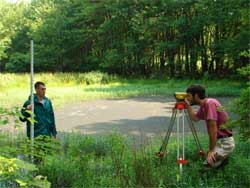 KINGSTON, R.I. – August 15, 2006 – Few people consider those shallow, seasonal pools in the forest to have much value, but University of Rhode Island Professor Frank Golet would disagree. According to Golet, seasonal or “vernal” pools can be exceedingly important habitats for certain amphibians—frogs, toads and salamanders—and other wild creatures that depend upon them for breeding sites.
KINGSTON, R.I. – August 15, 2006 – Few people consider those shallow, seasonal pools in the forest to have much value, but University of Rhode Island Professor Frank Golet would disagree. According to Golet, seasonal or “vernal” pools can be exceedingly important habitats for certain amphibians—frogs, toads and salamanders—and other wild creatures that depend upon them for breeding sites.
To reproduce successfully, pool-breeding amphibians need pools with the right characteristics, but they also need undisturbed forests around the pools, where they live during the remainder of the year. Golet is leading a team of researchers on a yearlong study of the vernal pools in the Queen River watershed of Rhode Island to determine which pools, and which areas of the watershed, nurture the largest populations and greatest diversity of pool-breeding amphibians. He calls such areas “hotspots.”
“We’re seeking to identify the hotspots so that plans can be made to protect them by one means or another,” said Golet, who was awarded a grant from the R.I. Department of Environmental Management to conduct the study.
One of the cleanest waterways in Rhode Island, the Queen River watershed lies primarily in the towns of West Greenwich, Exeter, Richmond and South Kingstown. The river empties into the Great Swamp Management Area. “We selected the Queen River watershed for our study because it is one of the least impacted by human activities in the state and is a high priority area for conservation for several groups and agencies,” said Golet.
Mid-way through the project, the researchers have already surveyed more than 100 vernal pools, and they plan to monitor about 60 of them throughout the remainder of the year. One of the most important factors in assessing a pool’s habitat value is its hydroperiod—the length of time when the pool has standing water.
“Different amphibians need different periods of inundation for successful reproduction,” explained Golet, a wetlands ecologist who resides in West Kingston. “Pools need to retain water long enough for the larvae to complete their development and move into the surrounding upland where they will live as adults. If the pool dries up too soon, the animals will perish. Permanent ponds, on the other hand, are generally poor breeding sites because they support fish, which may eat amphibian eggs, larvae, and adults.”
So the researchers estimate each pool’s hydroperiod after examining its depth, geology, tree canopy cover, water chemistry, and other features in the field. To assess the suitability of the surroundings, they estimate the amount of forest within various distances of the pool using Geographic Information System (GIS) technology.
Many of the vernal pools Golet’s team is surveying are on private property, and they needed to obtain permission from these landowners before proceeding with their research. “Most of the landowners are happy to participate so they can learn a little more about what’s living on their property and contribute to wildlife conservation,” Golet said.
The ultimate goal is to use the gathered information to target specific pools, pool clusters, and surrounding forest areas for protection. There are various ways that such habitat can be protected, Golet noted, including public acquisition, conservation easements, and the use of best management practices during land development. He emphasized that the project is not regulatory in nature but, rather, proactive.
“We are hopeful that, if successful, our approach in this watershed can be used in other watersheds as well,” he said.

